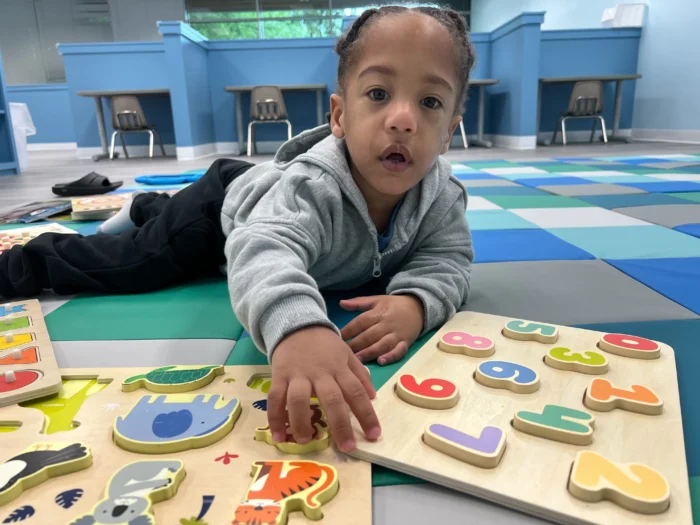
If your toddler has been diagnosed with autism or you suspect they may be on the spectrum, ABA therapy is a highly regarded, evidence-based treatment option. Early intervention can play a crucial role in supporting their development and well-being, helping toddlers build essential skills that set the foundation for their future.
In this guide, we’ll explore how ABA therapy for toddlers works, its key benefits, and how to implement it effectively.
What Is ABA Therapy for Toddlers?

ABA therapy (Applied Behavior Analysis) is a structured intervention designed to support toddlers with Autism Spectrum Disorder (ASD) by focusing on communication, social, and behavioral skills. Starting ABA therapy early can nurture a child’s ability to engage with the world around them and build meaningful connections with others.
ABA strategies break tasks into manageable steps, helping toddlers build confidence through small, achievable milestones. This personalized, research-backed approach doesn’t just address ASD, it equips toddlers with tools to thrive in their daily lives, and we are happy to witness its progress every day.
How Does ABA Therapy Work for Toddlers?
At Abacus Therapies, each highly customized ABA session is tailored to support each toddler’s unique needs. Sessions typically last a few hours and focus on building essential skills for their stage of development.
ABA therapy for toddlers often feels like guided play. ABA activities such as role-playing, puzzles, storytelling, and dance are used to:
- Identify and express emotions
- Follow instructions
- Practice basic social interactions
The frequency and duration of ABA therapy sessions are determined through a comprehensive evaluation by the child’s care team, which includes family members and a Board-Certified Behavior Analyst (BCBA).
While recommendations vary according to multiple factors including autism type, most toddlers benefit from 2–5 hours of ABA therapy per day.
A BCBA designs the therapy plan, while Registered Behavior Technicians (RBTs) work closely with toddlers to implement engaging learning experiences.
Some common ABA techniques for toddlers include:
- Discrete Trial Training (DTT): Structured, repetitive skill-building activities
- Natural Environment Training (NET): Learning through play in familiar settings
- Picture Exchange Communication System (PECS): A visual communication method for nonverbal toddlers
We aim to create a supportive learning environment by incorporating your toddler’s favorite toys and activities as positive reinforcement. This keeps them motivated and engaged as they grow and develop. With time, activities become more structured, always adapting to their individual pace.
Home vs. Clinic ABA Therapy for Toddlers

ABA therapy can take place at home, in an ABA therapy center, or a combination of settings. The best option depends on the child’s learning style and family dynamics.
- Home-Based ABA integrates therapy into daily routines, such as using picture cards at mealtime to encourage communication, or practicing cooperative play with siblings to improve social interactions.
- Clinic-Based ABA provides a structured setting with peer interaction, group play, and sensory activities like playdough or water tables to enhance motor and social skills.
Both settings have unique advantages, and many families combine home and clinic sessions for a well-rounded approach.
How ABA Therapy Benefits Toddlers
ABA therapy has a profound impact on early childhood development, supporting toddlers in key areas such as:
- Social skills: Encourages interaction and engagement with peers and caregivers, improving their ability to make friends and interact socially.
- Boosting autonomy: Builds daily living skills like dressing, eating, and toileting, crucial for their preschool years.
- Behavioral growth: By understanding a child’s needs and identifying triggers, ABA helps them develop constructive ways to express themselves.
- Increasing communication: Children learn verbal and nonverbal ways of expressing needs and emotions through ABA activities for toddlers that focus on communication.
Early and personalized intervention helps children build a strong foundation for growth in academic, social, and personal areas. While seeing effects takes time, each step forward is valuable, and with patience and consistency, you’ll see meaningful development.
Is There an Age Limit for ABA Therapy?
ABA therapy can be beneficial at any age. Research shows that autism can often be identified as early as 18 months, making early intervention key. Many children begin ABA around age two, helping them build essential skills from the start.
Final Reflections
Starting ABA therapy early can make a transformative difference in a toddler’s ability to communicate, interact, and develop independence. At Abacus Therapies, we are committed to providing personalized, compassionate ABA therapy to support your child’s unique growth journey.
If you have questions or are ready to explore how ABA therapy can help your child, contact us today. We’re here to guide you every step of the way!
FAQs
What is the best age to start ABA therapy?
The ideal time to begin ABA therapy is between 18 months and 2–3 years old, taking advantage of early brain development for maximum impact. That being said, even if you start ABA therapy at the age of six, you are likely to see your child’s well-being increase.
How do I know if my child needs ABA therapy?
If your child experiences challenges with communication, social interactions, sensory processing, or expressing emotions, ABA therapy can provide valuable support. A consultation with a specialist can help determine if ABA is the right fit for their unique needs.
How long are ABA therapy sessions?
Sessions typically last 2–5 hours, but this can vary depending on the child’s age, needs, and goals. Some children may benefit from shorter or longer sessions.



